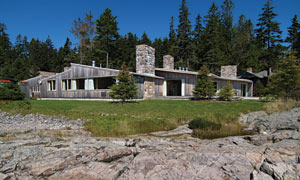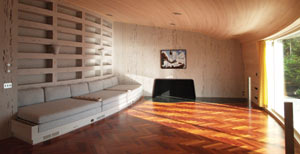July / August 2010
A charmed restoration of a one-of-a-kind modernist residence gets it right, down to the last detail.
By Brad Favreau
 Summer homes are not particularly unusual here in Maine, but the home William Burden and his wife Margaret built during the late 1940s proved to be a rarity among its neighboring seaside homes. While most ocean houses favor Colonial Revival or the Shingle Style, the Burdens dared to create a modernist gem that would soon become as essential to the Maine coast as the rocky shore or the cool, salty breezes that whip past the nearest lighthouse.
Summer homes are not particularly unusual here in Maine, but the home William Burden and his wife Margaret built during the late 1940s proved to be a rarity among its neighboring seaside homes. While most ocean houses favor Colonial Revival or the Shingle Style, the Burdens dared to create a modernist gem that would soon become as essential to the Maine coast as the rocky shore or the cool, salty breezes that whip past the nearest lighthouse.
When fire struck down the house in 1998, there was no question it would be rebuilt. But as times have changed since the post-war period, so have building methods and materials. In order to recreate the house that the Burden family had always loved, a team of builders, artisans, and designers led by Boston-area architect Heinrich Hermann had to perform “some structural acrobatics” in rebuilding to meet current codes. But as talented as this team was, Fate, on more than on one occasion, played an important part in the effort to bring the house back–true and accurate–to the original.
William Armistead Moale Burden, hailing from the Vanderbilt family, was a financier, art collector, and diplomat (serving as Ambassador to Belgium from 1959 to 1961). In the late 1940s, he engaged architect Wallace Kirkman Harrison to design his summer house in Maine. Though not widely known today, during his heyday Harrison collaborated with such 20th-century architectural masters as Le Corbusier, Philip Johnson, and Eero Saarinen, all strong proponents of modernist architecture, experimenting with design that sprung from the International Style that had been defined twenty years earlier. Among Harrison’s portfolio of later works are major projects such as the Time-Life Building and the Exxon Building, both at Rockefeller Center in New York City, and the Metropolitan Opera House at Lincoln Center in New York. Talent and credentials aside, it was likely that Burden chose Harrison because Harrison had designed the summer house of his close friend, Nelson Rockefeller.
 Important to Harrison as he designed the Burdens’ house was the idea of human movement through space. With this in mind, he developed initial drawings but remained unsatisfied that he’d captured the idea properly. He turned to Japanese-American artist and designer Isamu Noguchi for help. Noguchi was known for his eagerness to work among many disciplines and in many different media, and his work was prolific. He worked in sculpture, landscape architecture, furniture design, and painting, but probably what intrigued Harrison most was Noguchi’s work as set designer for famed choreographer Martha Graham.
Important to Harrison as he designed the Burdens’ house was the idea of human movement through space. With this in mind, he developed initial drawings but remained unsatisfied that he’d captured the idea properly. He turned to Japanese-American artist and designer Isamu Noguchi for help. Noguchi was known for his eagerness to work among many disciplines and in many different media, and his work was prolific. He worked in sculpture, landscape architecture, furniture design, and painting, but probably what intrigued Harrison most was Noguchi’s work as set designer for famed choreographer Martha Graham.
Harrison’s instincts proved correct. Noguchi was able to articulate the dynamic quality of design that had, to that point, eluded Harrison. His preliminary floor plan remained intact, but Noguchi’s work on the house’s elevations and cross sections lifted the design from middling to masterful. Noguchi imparted a curvilinear, sculptural elegance that gave the house a supple and relaxed appeal, and “created a choreography of movement between the living room and dining room,” says Hermann. “Once Noguchi was involved, the space took on palpable fluidity.”
For fifty years, the house remained a constant in the Burden family’s life, a dependable retreat here in Vacationland used to relax and unwind. It passed from William and Margaret to their youngest son Ordway and his wife, Jean, in 1996, and during all those years managed to maintain the character of design that Harrison and Noguchi created in 1947.
And it was about this time that Providence descended upon the house.
Elizabeth Dean Hermann, professor at Rhode Island School of Design, visited the Burden home in 1998 as part of her research on artistic identity of the 1940s and 1950s, in particular the collaboration between Wallace Harrison and Isamu Noguchi. Accompanying her that day, acting as photographer, was her husband, Heinrich. What they initially believed would be a two- or three-hour field trip lasted a full day as the pair studied the house’s design, inspecting various building details and marveling at the many subtle clues to the house’s exquisite craftsmanship. Heinrich filled ten rolls of film, wishing he’d brought more. “I was completely captivated by the house,” he says. Not for a moment did he realize that the dozens of images he took that day would serve more than his wife’s research project. Heinrich had completely photo-documented the house, practically inch-by-inch, creating a record that would later prove indescribably important to the house’s restoration.
“Happy,” “hapless,” and “happen” all stem from the root word “hap,” which is defined as fortune or chance. If something “happens,” it suggests an occurrence of luck or kismet. Heinrich Hermann happened to go along with his wife that day and happened to photograph the house. This episode was but one of Fate’s interventions.
Fire, the cause of which remains unknown, destroyed the house the following summer. “What was left were parts of the pool and the granite chimneys,” Hermann says, along with partially melted andirons Noguchi had designed for the living room fireplace. No one was physically harmed, but the hurt of losing their beloved house prompted Jean and Ordway Burden to recreate it just as it had always been. “It was the perfect house for us,” Jean says. “It would be hard to make a better house.”
When the claim was filed, the insurance company hired an architectural firm to reproduce building plans for the house. Jean Burden, who studied architecture at Harvard University’s Graduate School of Design, sensed these plans would not be sufficient to bring her house back to its original state. She asked Hermann to review the plans, as he’d become intimately familiar with the house during his photo shoot. After careful review, Hermann confirmed they lacked many of the house’s exceptional details. Armed with a copy of Harrison’s original set of plans (which happened to have been donated to Columbia University by the project manager who’d supervised construction of the house), he traveled to the company’s headquarters in New York City. Ready to go to battle if necessary, Hermann was astonished to find the company agreeing that the plans they’d provided were insufficient. As it turned out, one of the directors of the company, an engineer by training, happened to have interned many years earlier with Wallace Harrison. He acknowledged that a true restoration of the house was in order.
It was then that Hermann began the difficult task of reproducing the specifications for the house. Even with photographs in hand, it seemed impossible to know exactly what materials and fixtures were used originally to outfit the house. Good fortune again supplied a major piece of the puzzle. The Burdens’ nephew happened to have saved, for more than fifty years, the house’s original specifications as detailed by Harrison among his personal papers.
 Knowing exactly what was used was very useful, but locating items and materials that may or may not be in production any longer was daunting. “I felt like Sherlock Holmes all the time,” Hermann says. “The Internet was helpful,” but sometimes things appear in quite unexpected places. One of the features of the house was plywood wall panels with a grooved pattern cut into the wood. These panels, called Weldtex, were sometimes found in mid-century modernist homes, but, as Hermann discovered after tracing the manufacturer through multiple changes of owners, it is no longer made. It could be custom-made, however, if he had a sample showing exactly how the grooves were cut. During this same time, he and Elizabeth were shopping for their own home in Massachusetts. While looking at a house of roughly the same vintage as the Burden home, he happened to stumble across an unfinished piece of this wood that was large enough to show the pattern. From there, he had woodworking knives specially made to mill Douglas fir plywood into the panels he needed. That small piece of plywood almost seemed to have been lying about in the basement of the house that Heinrich and Elizabeth Hermann would eventually buy, waiting for him to stop by.
Knowing exactly what was used was very useful, but locating items and materials that may or may not be in production any longer was daunting. “I felt like Sherlock Holmes all the time,” Hermann says. “The Internet was helpful,” but sometimes things appear in quite unexpected places. One of the features of the house was plywood wall panels with a grooved pattern cut into the wood. These panels, called Weldtex, were sometimes found in mid-century modernist homes, but, as Hermann discovered after tracing the manufacturer through multiple changes of owners, it is no longer made. It could be custom-made, however, if he had a sample showing exactly how the grooves were cut. During this same time, he and Elizabeth were shopping for their own home in Massachusetts. While looking at a house of roughly the same vintage as the Burden home, he happened to stumble across an unfinished piece of this wood that was large enough to show the pattern. From there, he had woodworking knives specially made to mill Douglas fir plywood into the panels he needed. That small piece of plywood almost seemed to have been lying about in the basement of the house that Heinrich and Elizabeth Hermann would eventually buy, waiting for him to stop by.
Similarly, Hermann had great difficulty locating an exact match for the marble used in the master bathrooms (one his, one hers). He tracked down a lead to a stone dealer in New York City. Although this particular marble was from a long-ago-closed quarry in France, this dealer happened to have the same stone in his warehouse. These slabs were only three-quarter-inch thick, not the two-inch thick slabs used in 1947, but Hermann knew what a great find this was and purchased them. The dealer had stored this marble in his warehouse for decades, somehow unable to part with it, even turning down offers from other buyers. It was almost as though he was waiting for the right person, Heinrich Hermann, to make an offer.
While the house was being built (the first time), the Burdens had commissioned Noguchi to design a dining table that would accentuate the fluidity of the living and dining rooms. The piece he created–a beautiful birch table reminiscent of a boomerang–became a modernist furniture icon almost immediately. “It was really more like a sculpture,” says Jean Burden. “It was the heart of the house.” After the fire, all that remained were photographs and memories. Duplicating such a custom piece seemed impossible, but the house would not be the same without the table. Yet again, Fate supplied the answer to this difficult problem. During their research, Heinrich and Elizabeth discovered that the grandson of the original contractor happened to still own, after more than five decades, the plaster model that Noguchi used in 1947. A three-dimensional scan of the model, expert craftsmanship, and time provided a reproduction that is nearly indistinguishable from the original.
Time after time, Hermann and his team found circumstance yielding to extraordinary coincidence while rebuilding the Burdens’ home. It was hard work; the restoration took almost seven years (at the start it was estimated to take only two), but the Universe would see the house again stand strong against the Downeast winds. Luck, good fortune, destiny, or happenstance; whatever it’s called, it followed Hermann and the Burdens along their journey to restore Wallace Harrison and Isamu Noguchi’s vision of a modernist seaside retreat. Visitors who saw the house before the fire have since returned, and if any one of them had not known of the fire, he or she would not have realized anything changed.
Exactly as it was meant to be.





0 Comments